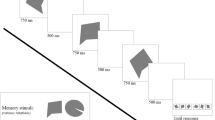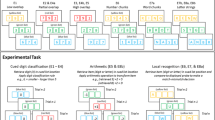Abstract
Stimulus-independent thoughts (SITs) are streams of thoughts and images unrelated to immediate sensory input. Four experiments examined the contribution of aspects of working memory to production of SITs. In Experiments 1 and 2, interventions that were targeted on, respectively, phonological and visuospatial components of working memory both interfered with production of SITs, but there was evidence that these tasks also made demands on central executive resources. Experiments 3 and 4 specifically examined the hypothesis that production of SITs and control of nonproceduralized tasks both depend on central executive resources, and so should show mutual interference. In Experiment 3, prior practice on pursuit rotor and memory tasks reduced the interference with SITs from concurrent task performance. In Experiment 4, randomness within a task involving random-number generation was less when SITs were being produced concurrently than it was when they were not. The results suggest that production of SITs depends on central executive resources.
Article PDF
Similar content being viewed by others
Avoid common mistakes on your manuscript.
References
Allport, D. A. (1980). Attention and performance. In G. Claxton (Ed.),Cognitive psychology: New directions (pp. 112–153). London: Routledge & Kegan Paul.
Antrobus, J. S. (1968). Information theory and stimulus-independent thought.British Journal of Psychology,59, 423–430.
Baddeley, A. D. (1986).Working memory. Oxford: Oxford University Press.
Baddeley, A. D., Eldridge, M., Lewis, V., &Thomson, N. (1984). Attention and retrieval from long-term memory.Journal of Experimental Psychology: General,113, 518–540.
Baddeley, A. D., &Hitch, G. J. (1974). Working memory. In G. H. Bower (Ed.),The psychology of learning and motivation (Vol. 8, pp. 47–89). New York: Academic Press.
Barnard, P. J., &Teasdale, J. D. (1991). Interacting cognitive subsystems: A systemic approach to cognitive-affective interaction and change.Cognition & Emotion,5, 1–39.
Beck, A. T. (1976).Cognitive therapy and the emotional disorders. New York: International Universities Press.
Bilodeau, E. A., &Bilodeau, I. M. (1961). Motor skills learning.Annual Review of Psychology,12, 243–280.
Borkovec, T. D., &Boudewyns, P. A. (1976). Treatment of insomnia with stimulus control and progressive relaxation procedures. In J. D. Krumbolz & C. E. Thoresen (Eds.),Counselling methods (pp. 328–344). New York: Holt, Rinehart & Winston.
Borkovec, T. D., Robinson, E., Pruzinsky, T., &DePree, J. A. (1983). Preliminary exploration of worry: Some characteristics and processes.Behaviour Research & Therapy,21, 9–16.
Eskstrom, R. B., French, J. W., Harman, H. H., &Derman, D. (1976).Manual for kit of factor-referenced cognitive tests. Princeton, NJ: Educational Testing Service.
Evans, F. J. (1978). Monotoring attention deployment by random number generation: An index to measure subjective randomness.Bulletin of the Psychonomic Society,12, 35–38.
Eysenck, M. W. (1982).Attention and arousal: Cognition and performance. Berlin: Springer-Verlag.
Farmer, E. W., Berman, J. V. F., &Fletcher, Y. L. (1986). Evidence for a visuo-spatial scratch-pad in working-memory.Quarterly Journal of Experimental Psychology,38A, 675–688.
Fodor, J. (1983).The modularity of mind. An essay on faculty psychology. Cambridge, MA: MIT Press, Bradford Books.
Levey, A. B., Aldaz, J. A., Watts, F. N., &Coyle, K. (1991). Articulatory suppression and the treatment of insomnia.Behaviour Research & Therapy,29, 85–89.
Norman, D. A., &Shallice, T. (1986). Attention to action: Willed and automatic control of behaviour. In G. E. Schwartz & D. Shapiro (Eds.),Consciousness and self-regulation: Advances in research and theory (Vol. 4, pp. 1–18). New York: Plenum.
Rapee, R. M. (1991). Generalized anxiety disorder: A review of clinical features and theoretical concepts.Clinical Psychology Review,11, 419–440.
Rapee, R. M. (1993). The utilisation of working memory by worry.Behaviour Research & Therapy,31, 617–620.
Shallice, T. (1988).From neuropsychology to mental structure. Cambridge: Cambridge University Press.
Singer, J. L. (1966).Daydreaming. New York: Random House.
Singer, J. L. (1988). Sampling on-going consciousness and emotional experiences: Implications for health. In M. J. Horowitz (Ed.),Psychodynamics and cognition (pp. 297–346). Chicago: University of Chicago Press.
Teasdale, J. D. (1989). Daydreaming, depression, and distraction.The Psychologist,2, 189–190.
Teasdale, J. D., &Barnard, P. J. (1993).Affect, cognition, and change: Remodelling depressive thought. Hove, U.K.: Erlbaum.
Teasdale, J. D., Proctor, L., Lloyd, C. A., &Baddeley, A. D. (1993). Working memory and stimulus-independent thought: Effects of memory load and presentation rate.European Journal of Cognitive Psychology,5, 417–433.
Tulving, E. (1962). Subjective organization in free recall of “unrelated” words.Psychological Review,69, 344–354.
Author information
Authors and Affiliations
Rights and permissions
About this article
Cite this article
Teasdale, J.D., Dritschel, B.H., Taylor, M.J. et al. Stimulus-independent thought depends on central executive resources. Memory & Cognition 23, 551–559 (1995). https://doi.org/10.3758/BF03197257
Received:
Accepted:
Issue Date:
DOI: https://doi.org/10.3758/BF03197257




